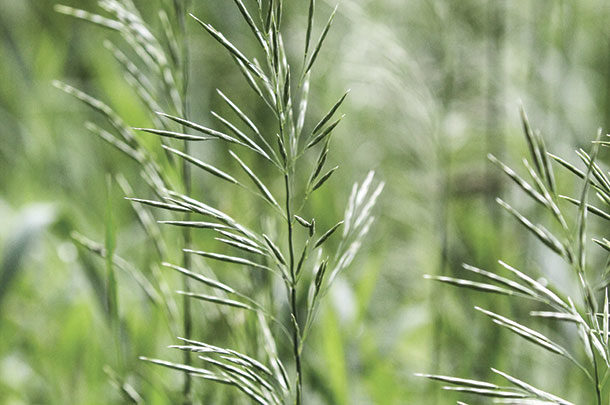But considering the strengths and weaknesses of each species can help bring clarity. For this article, I’ll only consider perennial cool-season grasses used in the East, or in the West under irrigation. Natives and annuals are not listed.
A good place to start is to observe neighboring operations and look in ditches and along fencerows, to see what grows naturally in your area. Here is a list of some of the more popular cool-season grasses to choose from, along with some of the important characteristics of each:
Smooth brome
- Naturalized across the Plains states and in the Rocky Mountain region
- Spreads by rhizomes
- Matures much earlier than alfalfa
- Slow regrowth
- Can outcompete alfalfa and other grasses over time
- Best used in situations where longevity is more important than yield
Meadow brome
- Found extensively in Canada, the northern Rockies and Great Plains
- Compared to smooth brome, meadow brome does not have aggressive rhizomes
- Better regrowth after the first harvest than smooth brome
- A better companion with alfalfa than smooth brome (but there are better choices on this list)
Timothy
- Found in wet areas in the northern tier of states and Canada
- Features one big cut and then very little regrowth for the rest of the year
- The latest heading of all these listed cool-season grasses
- An early heading variety matches grass heading with alfalfa bloom time
- Can be planted in the fall, harvested once in the spring and then rotated out
Tall fescue
- Naturalized from the transition zone all the way to the Canadian border
- Widely adapted to wet soils, occasional drought and all but the most extreme heat and cold
- New-generation varieties can be late enough to plant with alfalfa
- In most environments, tall fescue will be the highest-yielding species on this list
Meadow fescue
- Historically popular everywhere except in the South
- Replaced by tall fescue based solely on dry matter production
- More winter hardy than tall fescue
- Tolerates wet soil and close grazing better than tall fescue
- Higher quality than tall fescue
- Proving to be a great companion with alfalfa in the Upper Midwest and Northeast
Orchardgrass
- Found growing everywhere from the transition zone north and from east to west in areas with at least 20 inches of precipitation
- Many diverse varieties to choose from to match climates and management styles
- In ideal conditions, can outyield nearly all other cool-season grasses
- Very quick regrowth can be a huge advantage, but must be carefully managed when grazing
- Does not do well in extremely hot or dry conditions
Perennial ryegrass
- By far and away the dominant grass used for livestock across the globe
- Very well-suited on the Pacific coasts and around the Great Lakes
- Has the highest energy level of any grasses on this list
- Not very long-lived, and it does dry well for dry hay
- Needs high fertility to thrive
- Easy to overseed into thin stands due to high seedling vigor
Festulolium
- A cross between a ryegrass (perennial or Italian) and a fescue (either a tall fescue or a meadow fescue)
- Tall fescue types behave like tall fescue but have better forage quality and palatability than tall fescue
- Ryegrass types look like ryegrass but last a bit longer into summer drought periods and have higher tonnage compared to perennial ryegrass
In closing, a few words on selecting varieties might be helpful. There is wide variation between varieties, so these species-level generalizations are not precise. But hopefully they will serve to guide you as you decide which grasses may work best on your operations. I have purposely stayed away from mentioning varieties above. There are probably hundreds of them if you add up all the species from this list.
The best variety for you will be heavily dependent on where you live and how you manage it. A careful study of seed company literature and internet searches can give you clues about how varieties might perform for you. Unlike some other crops, there are not well-established standards for testing grasses.
Terms like “late maturing” and “winter hardy” are relative. Standards are being worked on by some industry groups and the American Forage and Grassland Council, but they aren’t in place yet. Therefore, when you see terms like “disease resistant” or “late heading,” they are likely compared to other offerings from the same company and may be slightly different than varieties offered by another company down the road.
Also, the cool-season grasses on this list all like to grow in temperatures below 80ºF. If they tried to grow during extreme heat, it would take more energy to cool the plants than they could generate from photosynthesis, so they would die eventually. Cool-season grasses also can’t grow at temperatures below freezing. The best way for plants to avoid the extreme heat and cold is to shut down (go dormant).
You may have heard about summer dormant tall fescue, for instance. These plants shut down in the summer to ensure their survival through heat and drought stress. This is an excellent trait in Oklahoma, but probably not as important in Minnesota. In many species, you can find varieties that are winter-active.
As you might expect, these plants grow better at the low end of the temperature range, but they cannot grow below freezing. These plants are bred to grow right through the shorter days of winter, but they aren’t as good at shutting down in the fall to protect themselves through freezing temperatures. So perhaps winter activity is a useful trait in California, but not in Calgary.
Next time you pick up a brochure, analyze those bullet points – don’t just assume every feature of every variety is a benefit to you! Talk to your neighbors and local extension or NRCS office to see what varieties are being successfully grown in your area.
And remember that there is a place for all the cool-season grasses somewhere, but not one of these species belongs everywhere! Matching your management and weather with the right variety can go a long way toward a successful forage program. ![]()

-
Chad Hale
- Research and Acquisitions Manager
- Western Forage Resources
- Email Chad Hale









